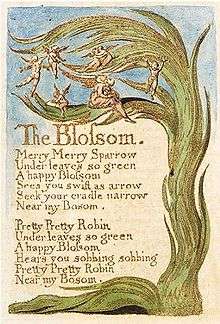The Blossom

"The Blossom" is a poem by William Blake, published in Songs of Innocence in 1789.
Analysis
This poem is full of cheerful images of life, such as the "leaves so green", and "happy blossom". The poem tells the tale of two different birds - a sparrow and a robin. The former is clearly content with its existence; whereas the latter is distraught with it, meaning the second stanza becomes full of negative, depressing images. This could be an attempt by Blake to portray the opinions of different groups of society - with one class (assumedly the ruling classes) content with maintaining the Status Quo, and the other class unfair with the changes required - as Robins traditionally appear during the Winter, one could assume that it is upset at having the miss the exciting, lively critiques that occur with summer - such as Blossoms.
Another possible interpretation is a sexual one, where the poem represents the joy that can be found through innocent sexual love. The sparrow, seeking his cradle 'swift as an arrow' has been interpreted in a phallic sense, and demonstrates the innocence and joy of free love. The 'happy blossom' in this sense is therefore the female sexual organs, which is happy upon seeing the arrival of the sparrow. The 'sobbing, sobbing' robin has been interpreted in several different ways. Either it is the opposite to the sparrow's open love, a creature who has been harmed through love or possibly violated, or it is another creature rejoicing in the joy of sexual love, in which case its sobbing could be orgasmic. Whilst this does sound a rather strange interpretation for a poem in 'The Songs of Innocence', Blake himself believed greatly in the joys of free love. Many of his poems, such as 'The Little Girl Lost and Found', 'The Lilly' or 'The Angel' also follow this theme of giving in to desires and sexual love.
Gallery
Scholars agree that "The Blossom" is the 11th object in the order of the original printings of the Songs of Innocence and of Experience. The following, represents a comparison of several of the extant copies of the poem, their print date, their order in that particular printing of the poems, and their holding institution:[1]
-
%2C_object_28_The_Blossom.jpg)
Songs of Innocence, copy B, 1789 (Library of Congress), object 28
-
_object_9_The_Blossom.jpg)
Songs of Innocence, copy G, 1789 (Yale Center for British Art) object 9
-
_object_8_The_Blossom.jpg)
Songs of Innocence, copy U, 1789 (Houghton Library) object 8
-
_object_11_The_Blossom.jpg)
Songs of Innocence and of Experience, copy Y, 1825 (Metropolitan Museum of Art) object 11
-
_object_11_The_Blossom.jpg)
Songs of Innocence and of Experience, copy Z, 1826 (Library of Congress) object 11
-
_object_11_The_Blossom.jpg)
Songs of Innocence and of Experience, copy AA, 1826 (The Fitzwilliam Museum) object 11
References
- ↑ Morris Eaves, Robert N. Essick, and Joseph Viscomi (eds.). "Comparison of Songs of Innocence's "The Blossom"". William Blake Archive. Retrieved January 31, 2014.
External links
| Wikisource has original text related to this article: |
- A Comparison of Extant copies of the original prints of "The Blossom" available from the William Blake Archive
- Project Gutenberg copy of Songs of Innocence and Songs of Experience, including The Blossom
- An Annotated Bibliography of Criticism of 'The Blossom'